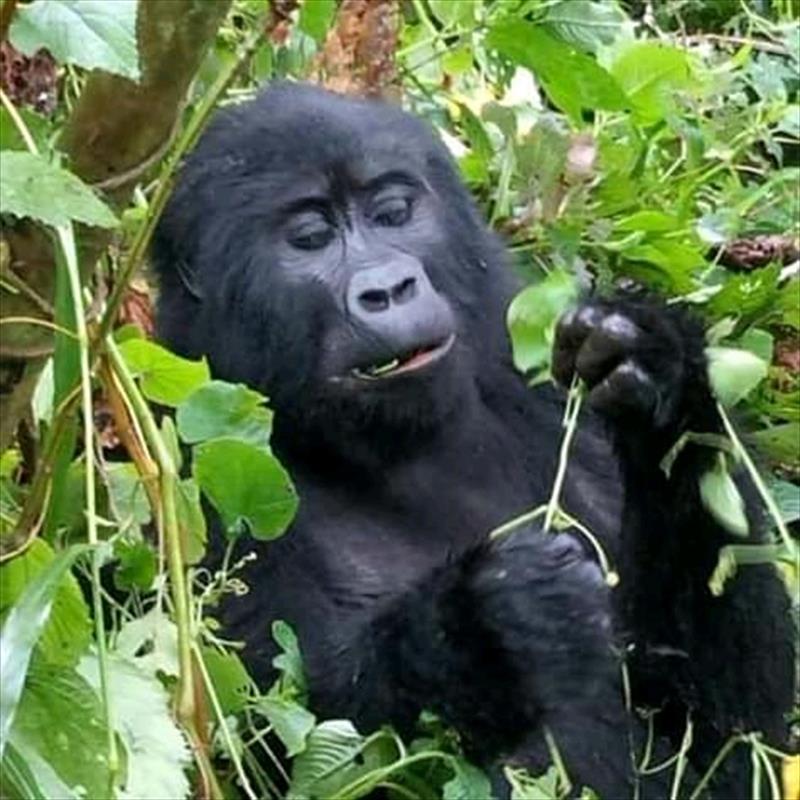BWINDI IMPENETRABLE NATIONAL PARK
At a size of 331sq.km, Bwindi Impenetrable National Park is one of Uganda’s smallest park.It’s a world class tourist destination sought after byastutetravelers to Africa dueto its prestigious heritage. The park is situated in the southwestern part of the country lying at the edge of the Rift Valley.In 1942, it was gazetted a Forest Reserve and lateruplifted in 1991 to a full status of a National Park and UNESCO recognized it as a World Heritage Site in 1994, popular for sheltering the Mountain Gorillas.
Small as it is, the park is home to almost half of the total population of the endangered Mountain Gorillas. The tangled vegetation, draped over a deeply fissured landscape of slippery valleys and high-draughty ridges offer absolute adventure to visitors on treks; “it is a place where only the brave can penetrate”. Its ever-chilly weather and puzzling terrain offers unrivalled atmosphere and serenity for visitors seeking to meet and interact with these interesting Great Apes.
Its altitudinal range is between 1160m- 2607m above sea level with an annual average temperature range of 70-200C, the coldest period being June and July. The forest is usually cold especially in the morning and during the nights, and receives up to 2390mm of rainfall annually; as a result, warm clothing and wet-weather gear is required.
Bwindi Impenetrable National Park protects the first group/ population of the Mountain Gorillas with the second inhabiting the forested depths of the Virunga Massif; a conservation area that spreads across three (3) countries and National Parks. Bwindi has over 14 Gorilla families habituated for tracking by visitors with one group/family available for research purposes. In April 1993, Mubare family,became the first group available for tracking by visitors after habituation.

How to get to the park
Bwindi Impenetrable National Park lies about 530km southwest of Kampala; a drive of about 9-10 hours from the country’s capital. There are various road routes to the park going through a scenic countryside. There are different routesto Buhoma; via Ntungamo-Rukungiri and Kihihi taking about 8hours and via Kabale and Ruhija, the route to Buhoma through Kabale and Kanungu as well as the route from Kampala to Nkuringo via Kabale being the longest.
The are other alternative routes to reach Bwind from the neighboring parks i.e.the route from Queen Elizabeth through Ishasha takes about 3-5 hours to Buhoma in the north of Nkuringo, Ruhija and Rushaga in the southern sections. From Mgahinga National Park in the south, the journey takes roughly 2hours.
There’s an alternative of tracking tours that originate from Rwanda and the drive from Kiali takes about 4-5hours to Bwindi via Kisoro.
Visitors to the park can also use domestic flights to Kihihi airstrip from Entebbe airport.
Wildlife in Bwindi Impenetrable Forest.
Bwindi is a mountain rainforest, an old and eco-biologically diverse forest. Bwindi shrouds a tremendous biodiversity as a result of three key factors; its slopes extend over a broad altitude of 1447metres to create habitats ranging from Lowland forests at 1160m to rare Afro-montane vegetation above 2600m, it is also extremely old believed to have survived during arid conditions of ice age and its part of the exceptionally rich Albertine Rift region.
Bwindi Impenetrable National Park’s eco-diversity ranges from its alluring evergreen vegetation composed of bamboo, to rivers and swamps among others. The forest has a lengthy list of wildlife species including; nearly 400species of plants with over 163 tree species and 100 species of ferns, 120 species of mammals with 10species of primates including the Mountain Gorillas, Chimpanzees, Baboons, L’Hoest Monkeys, Nocturnal Bush-babies and Red-tailed monkeys, among other mammals are the Elephants and various small Antelopes, 202butterfly species and 88 moths, plus 51 reptile species.
The park has an impressive list of birds of over 350 species including 23 Albertine Rift Endemics which accounts to 90% of the Albertine endemics such as the; African Green Broadbill,Shelley’s Crimson-wing, Short-tailed Warbler,White-tailed Blue flycatcher, Brown-necked Parrot, White-bellied Robinchat and Blue-headed Sunbird among others as well as seven IUCN Red Data listed species.
What to do in Bwindi
A world heritage site known for sheltering the Mountain Gorillas, Bwindi Impenetrable National Park offers superb wildlife encounters. With its range of eco and bio-diversity, the park is a jewel in the naturally endowed southwestern part of the country offering sheer forest adventure and a wealth of activities.
The park is famous for tracking the Mountain Gorillas, whose encounter and subsequent eye contact is the most electrifying and emotional wildlife experiences in the heart of Africa. Tracking these rare species is a captivating challenge, as you move through the steep and sometimes slippery terrain, with dense tangled forest, up into the misty mountain ranges (summit) where the Gorillas usually dwell. Once the Gorillas are located, an hour is usually availed to visitors to watch them.
The park also offers chance to spend more time with these great Apes on a rewarding Gorilla Habituation Experience, this activity allows visitors to accompany researchers and habituators, as they follow the Gorillas on their daily activity, and thereby getting them used to human presence without altering their natural habitat.
Bwindi’s alluring habitat range makes it an ideal birding destination; in 2012, Bwindi was voted Africa’s best birding site by the African Bird Club. It offers excellent sighting of the Albertine Rift Endemics, with 23 species. With its teeming primate diversity, trails through the forest enable visitors to trackprimates. Visitors can also participate in Mountain Biking through a well maintained 13km trail of Ivi River, as well as taking part in various breathtaking Nature Walks toexplorethe forest diversity. Trails such as Munyanga River, Waterfall trail, Muzabajiro Loop and Rushura Hill trails give opportune moments, for visitors to discover and experience this pristine forest.
